A Purpose-Built Precision Rifle Chassis
The Story Behind the PRC-700SA Chassis
(A Full List of PRC-700SA Chassis Models Can Be Found Here)
The concept for the PRC-700SA chassis began in October of 2017 at the close of the Wisconsin PRS season. While many more motivated shooters continue to spend a great deal of time at the range maintaining their perishable skills, I typically wind up spending the winter months reloading and tinkering with my equipment.
I met up with a good friend of mine (a skilled mechanical engineer and fellow PRS competitor) shortly after the WPRSC season finale to discuss an idea I had for a new barricade stop system for a precision rifle chassis. Eventually this conversation morphed into the idea of an entirely new chassis system featuring a full length Arca-Swiss rail, modular weight system, adjustable thumb rest, and a variety of other features.
At the time I was working at Criterion Barrels, and made occasional stops at our local dealers to discuss ongoing projects, make order deliveries, and keep up on the latest news. On one of these trips to American Defense Manufacturing (ADM) I made an off-hand comment regarding our chassis concept, which caught their interest and sparked the creation of a new product line.
We fleshed out the idea further in a series of after-work meetings, scratching out napkin sketches that turned into CAD drawings, which eventually turned into 3D prototypes. The general layout and design of the PRC-700SA was well on its way by the early months of 2018, but it took more than a year before we could start making chips on a prototype.
By early 2019 we had begun work on the DOPE Roller, founded Precision Rifle Components, and had all but written off the chassis project. It was to our great surprise when we received feedback that the project had been reactivated and was slated for release in SHOT Show of 2020! With the production support from ADM and a host of other ideas that had cropped up over the previous few calendar years, minor tweaks were made to the overall design and dialing in the final exterior geometry of the chassis body, cheek piece, and buttstock assembly.
The PRC-700SA Chassis – A Modular Mounting Platform
The foundation of most modern chassis system (or any modern rifle platform) is tied to its modularity. The ability to tweak, modify, and improve your rifle to fit your unique design preferences is essential in most competitive shooting disciplines.
While the action is the heart of the rifle, the chassis is its nervous system, tying all of the components together in one central interface. Mounting solutions are required for ballistic data, optics, night vision devices, monopods, bipods, tripods, shooting bags, comb risers, hand placement, recoil mitigation devices, brass catchers, rifle weights, and any number of other contraptions that can help provide a competitive edge.
During our development process we broke the chassis into three different subassemblies, the forend, the chassis body, and the stock assembly.
The Forend
The first element we considered in 2017 was the forend design. While the full length Arca-Swiss rail concept had already existed at that point, it was far from the industry norm. By incorporating an Arca-Swiss rail and three sides of M-Lok sections (another three sides of M-Lok rail sections are available in the PRC-700SA’s night vision bridge), there is no shortage of space to mount bipods, night vision devices, and modular weight systems. The Arca-Swiss rail allows for direct mount opportunities for tripods, as well as a wide, flat surface that helps build a stable shooting position off of bags or barricades.
Just as important as the exterior geometry of the forend is its method of attachment to the chassis body. Many chassis designs incorporate an annoying hump where the two pieces merge. That added beef allows for a rigid lockup between these two components, at the cost of creating an uneven surface less than optimal for riding a bag or an obstacle.
One of our primary goals with the chassis forend design was to allow the shooter to leverage the front of the magazine well as an effective 90 degree barricade stop. This was accomplished by securing the forend to the chassis body with two cross bolts and an additional reinforcing screw at the base of the assembly, just forward of the front action screw. An additional reinforcing measure includes the tongue and groove interface between the forend and the chassis body. Any downward pressure applied when loading up on the bipod serves only to apply tension to the contact point between the tongue and groove, minimizing vertical flex and maintaining a continuous strong, rigid profile. Keeping in mind the potential for future changes in firearm modularity and chassis design, we attempted to take steps to futureproof the PRC-700SA by enabling easy forend removal and replacement to accommodate both current and future accessory attachment systems.
Measuring out at just over 14”, the PRC-700SA forend is long enough to provide enough bearing space to perfectly accommodate a Gamechanger bag between your bipod and the front of the magazine well. The night vision bridge provides additional rigidity and offers an excellent position to run a bag strap around the barrel if you should so choose.
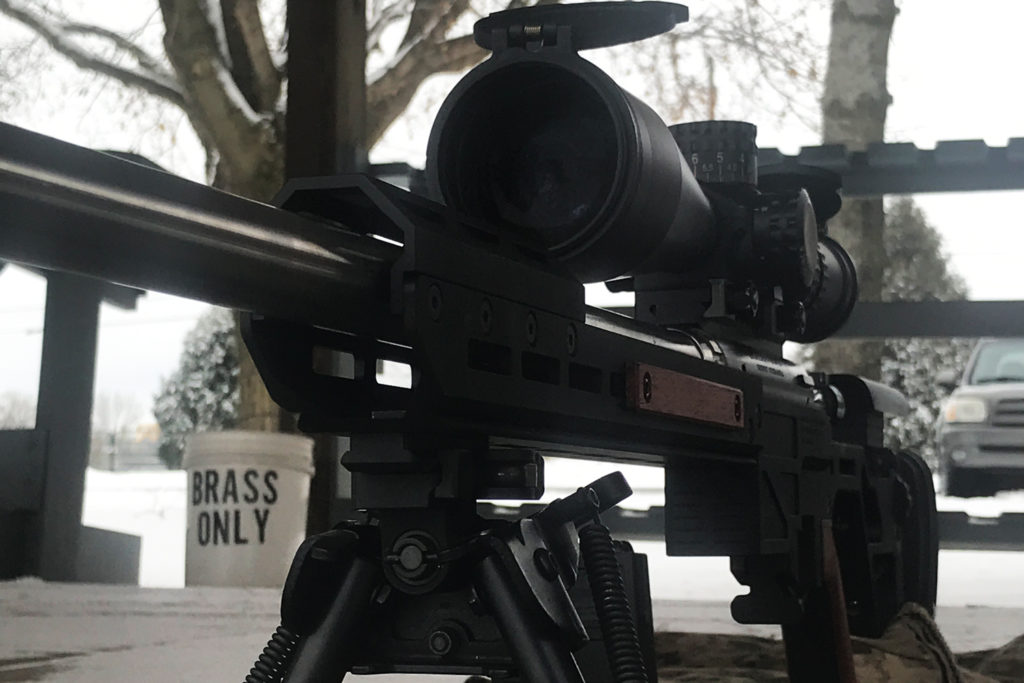
Pictured is the PRC-700SA Forend with Night Vision Bridge
The Chassis Body
Magazine Well
While some chassis manufacturers spent a great deal of machine time with intricate exterior geometry, the PRC-700SA sought to find an ideal balance between form and function. Having dealt with chassis that featured excessively loose and obnoxiously tight mag well dimensions, we sought to size ours in the sweet spot between. Testing a variety of different magazine manufacturers (PMAG, AI, Accurate-Mag, Vudoo, etc.) we sought to minimize wobble from side to side and front to rear (the source of many feeding issues with certain cartridges), while still allowing for smooth magazine release and reloads. The base of the mag well is beveled to provide the shooter with some margin of flexibility on feed angle, a feature sorely lacking in a number of DBM designs.
Magazine Release
While most of the chassis is fabricated from anodized or cerakoted 6061-T6 aluminum (multiple finish colors are available from the factory), the single piece magazine release is manufactured from steel to reduce wear after countless mag swaps. A simple lightly serrated paddle style engagement surface allows for magazine release with the classic “beer can grip”, while the side surface area also allows for a magazine release with a simple forward push of the index finger.
Trigger and Action Housing
The interior trigger housing is designed to accommodate a wide variety of aftermarket Remington 700 triggers, including some with some fairly unique exterior geometry (we tested Timney, Bix’n Andy, Trigger Tech, Remington, and Huber triggers during development). The trigger guard is sized to comfortably accommodate winter gloves. The chassis body features a Remington 700 footprint, and can accommodate recoil lugs of any thickness. Pre-fit barrel nuts from Northland Shooters Supply and Bighorn Arms (Now Zermatt Arms Inc.) also clear the chassis inlet.
QD Sling Studs
The PRC-700SA includes four QD sling studs at the midpoint and rear of the chassis assembly. QD sling stud attachments can be installed on the M-Lok rail sections on the front of the chassis as well. The midpoint QD sling studs can be rotated 360 degrees, creating a perfect mounting point for the Precision Rifle Components DOPE Roller.
Pistol Grip Attachment
As far as ergonomics go, this part of a chassis can make or break a design. While much ado has been made about custom vertical grip designs and different interface options, there are more AR-15 pistol grip options on the market than any other, so we elected to take this approach.
This choice led to its own series of challenges. Traditionally I have always felt as though something was always “off” when it came to chassis featuring AR-15 pistol grips. While these grips felt natural on an AR-15, when plugged into a bolt action lever, they always came across as clunky and unnatural.
After extensive testing and evaluation of existing chassis designs, we came to the conclusion that this was due to the placement of the firing hand in relation to the trigger face and pistol grip. Existing chassis with AR-15 pistol grips also frequently featured the inclusion of a buffer tube mounting point. This buffer tube mounting point interfered with hand placement, uncomfortably engaging the web of the hand between the thumb and forefinger, or placing the pistol grip too low in relation to the trigger assembly to allow for ergonomic engagement. While functional and economical, this solution is less comfortable than the classic vertical grip solution.
With the PRC-700SA, our solution to this problem was twofold. For those that engage the pistol grip in the traditional manner (wrapping their thumb around the back of the pistol grip), we designed the radius to the rear of the pistol grip to rise higher up in the chassis than existing design. This encourages a high, firm pistol grip, and while it limits the selection of AR-15 grips to those that do not feature a beavertail (We’ve had good luck with Griffin Armament’s A3 grip, USGI M16A1 grips, Magpul K grips, and Sharps Bros AR Grip).
Adjustable Thumb Shelf
The second inclusion is one that is fairly unique to the PRC-700SA chassis, for shooters that prefer to keep their thumb offset alongside their trigger finger to help alleviate unwanted pressure on the rifle, dampen pulse, and enable quicker bolt manipulation.
While the development team recommended we add a thumb shelf for this style of shooting, we couldn’t agree on a single angle based on the differences in our hand size and thumb positioning. After some discussion we elected to incorporate an adjustable thumb shelf that could be loosened by an Allen key and rotated in five different angles based on the individual shooter’s preference. An added benefit to this thumb rest is the ability to maintain consistent positioning of the firing hand (and trigger finger) on the rifle from shot to shot.
Some free recoil shooters using classic stock designs occasionally implement a “pinching” technique between the rear of the trigger guard and the face of the trigger. This technique historically could not be applied to chassis featuring a pistol grip, but the placement of the thumb rest allows this technique to be utilized effectively with the PRC-700SA chassis system.
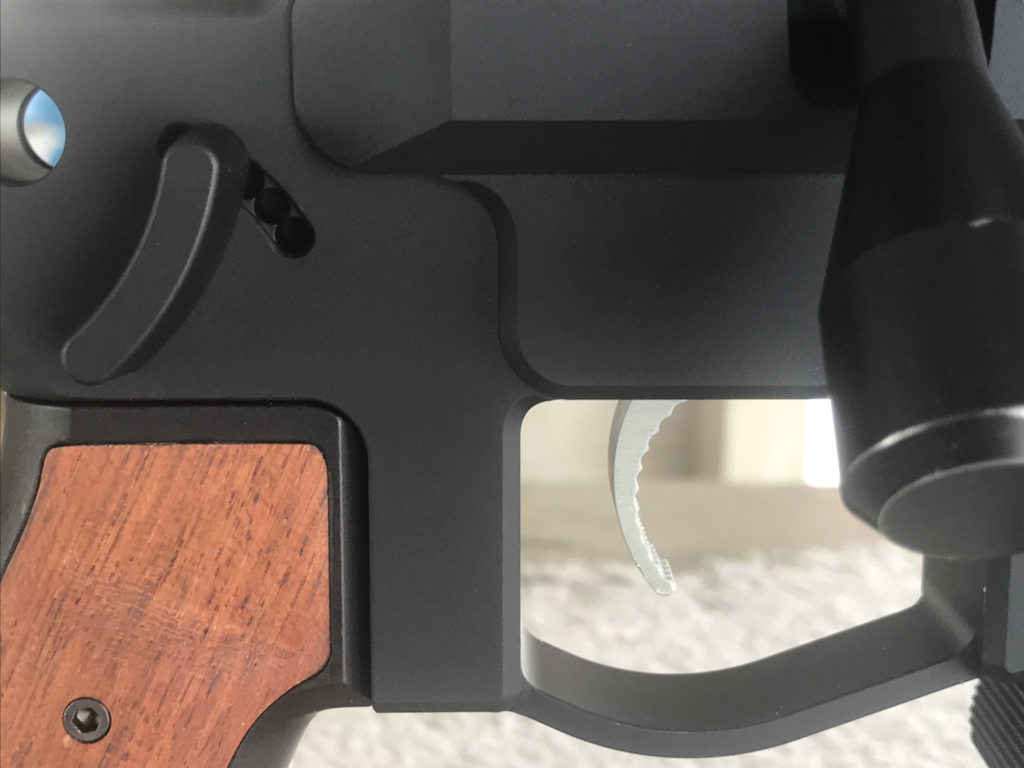
The PRC-700SA features a removable five position thumb rest.
The Buttstock Assembly
The PRC-700SA’s buttstock assembly incorporates adjustable length of pull and comb height. The adjustable length of pull is manipulated with a small finger wheel and detent, while the comb height is regulated through a stackable spacer system. The stock assembly is skeletonized, allowing for installation of a steel weight kit to adjust balance and further mitigate recoil. The cheek piece assembly engages to a Picatinny rail section along the top of the chassis, which is removable via ADM’s patented quick detach system. This allows for convenient barrel cleaning and provides additional clearance for a shooter’s cheek should they be interested in free-recoiling their rifle and maintaining a comfortable sight picture prior to pulling the trigger.
The base of the PRC-700SA includes a single M-Lok attachment point for the attachment of a monopod, with a flat smooth base that allows for a convenient engagement surface for rear bags of all shapes and sizes.
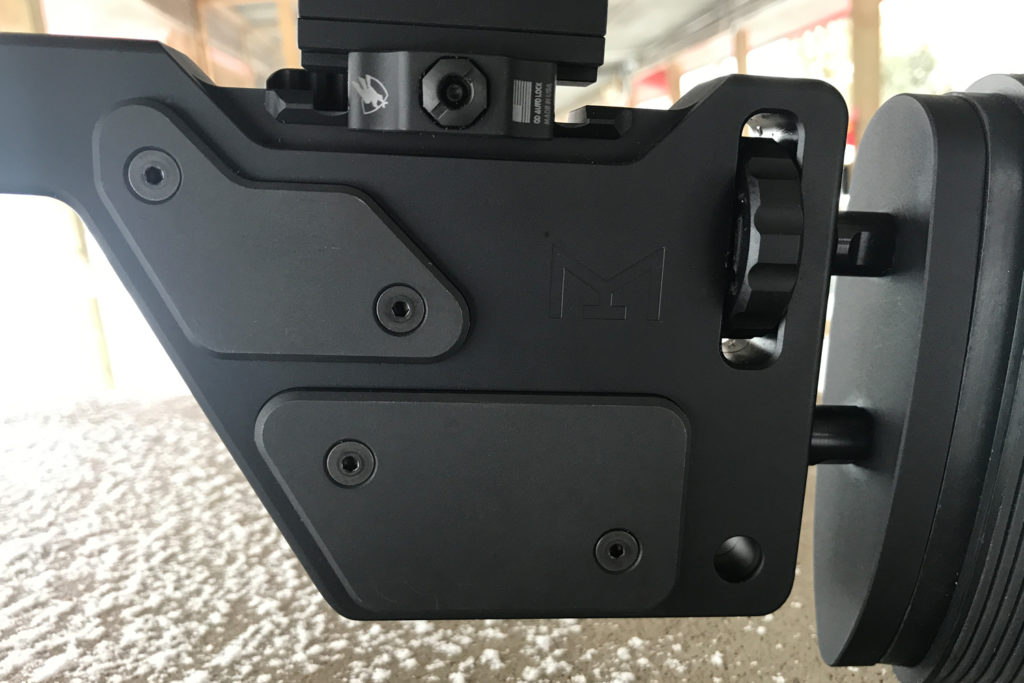
Pictured is the butt stock assembly with optional weight kit.
Other Assemblies
The DOPE Roller
The DOPE Roller is designed to provide a low profile mounting surface for presenting windage and elevation data without requiring shooters to break position from behind the rifle. Shooters can easily display and update their ballistic data by wrapping a simple 1” x 3” adhesive address label around the outside surface of the DOPE Roller.
The DOPE Roller is mountable to all 360 degree quick detach sling swivel studs, including the midpoint QD sling swivel stud found on the side of the PRC-700SA.
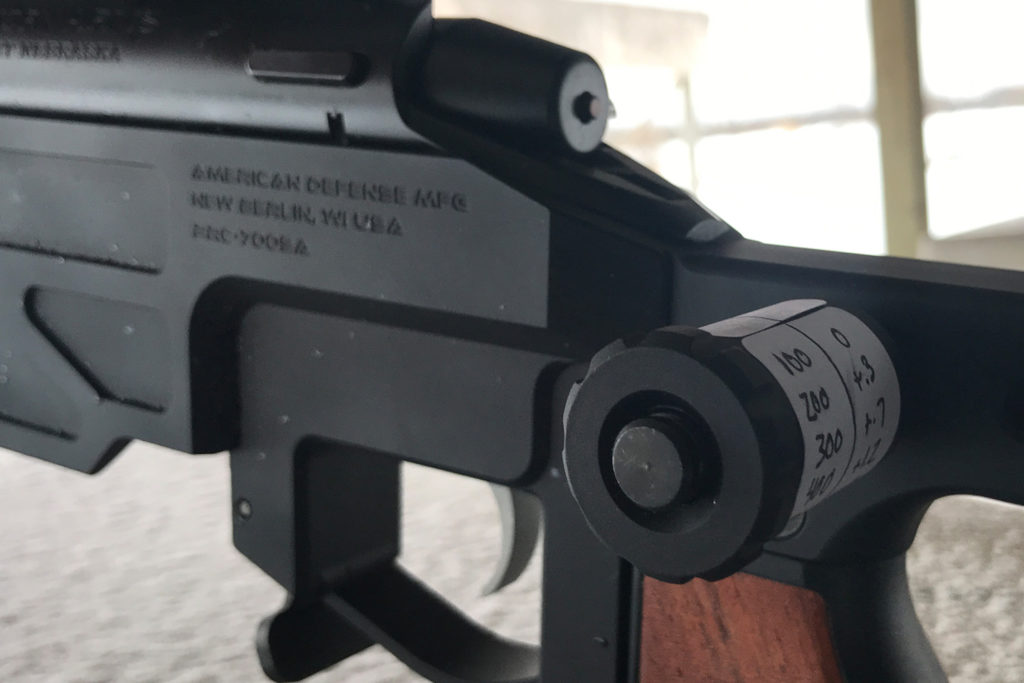
The PRC-700SA features QD sling studs perfectly placed for a DOPE Roller.
Gravity Blocks
If there have been three trends in PRS rifle design over the past few years, it has involved lighter recoiling high BC cartridges, handguards with wider forends for better barricade stability, and heavier rifle builds designed to further mitigate recoil. The Gravity Block single-handedly solves two of those issues. A stackable weight system, each steel Gravity Block weighs in at one pound and can be mounted directly to an M-Lok rail, Picatinny rail section (via an ADM QD lever mount), or stacked onto another Gravity Block.
While the overall PRC-700SA system weighs in at a manageable 4 lbs, 5 ounces, the attachment of the Gravity Block weight system can easily double, triple, or quadruple the overall weight of the chassis depending on the end user’s personal configuration preference.
The 2” width and flat base of each Gravity Block means that the end user can attach these weights to the base of a traditional slim AR-15 or Ruger Precision Rifle handguard, building a stable shooting position when emplaced upon a front bag or barricade. When installed in conjunction with the PRC-700’s buttstock weight system, a shooter can add approximately 10 pounds to the overall weight of their rifle (or more if they should choose to stack multiple Gravity Blocks along the base or sides of the rifle).
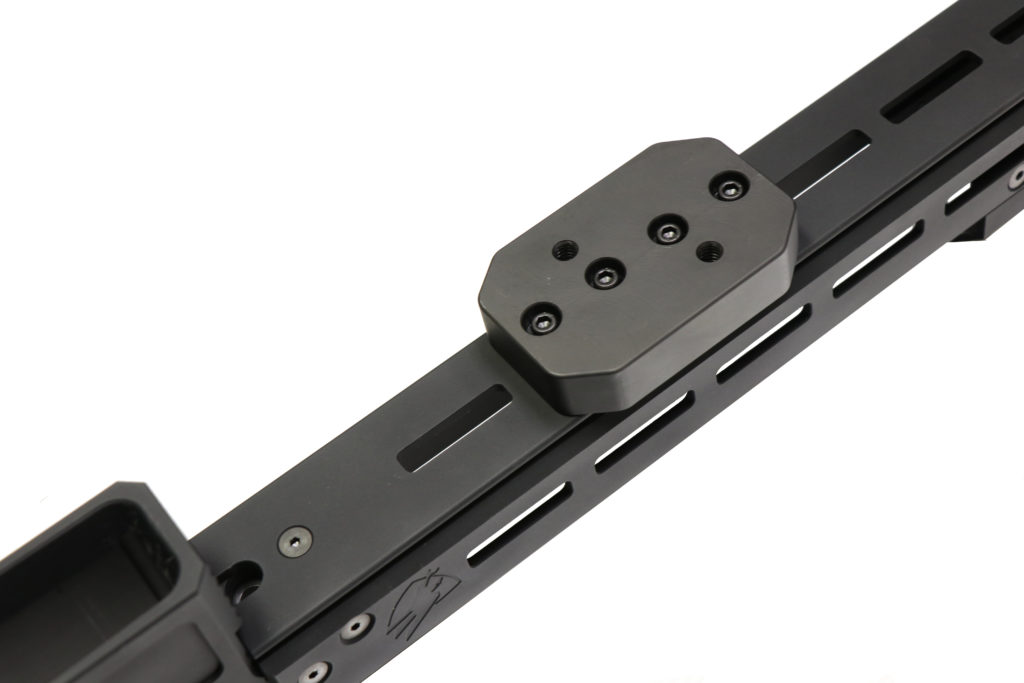
Pictured is a PRC-700SA forend with Gravity Block attached.
The PRC-700SA: The Birth of a New Chassis System
The PRC-700SA is more than just a chassis, it’s a central hub for an entire family of products, from Arca-Swiss bipod mounts, to Gravity Blocks, to the Precision Rifle Components DOPE Roller. From our early bowling alley bar napkin sketch sessions to prototype testing in the dead of the Wisconsin winter, I like to think that working on this project has been a great time for all of those involved. It brought together a great group of friends, spurred the creation of a new company, and spawned what we like to think is a pretty solid chassis design! We all hope you find as much enjoyment from the PRC-700SA as we have, and that it helps play a small but vital role in improving your hit-to-miss ratio.
If you are interested in purchasing a PRC-700SA Chassis, they are now available for order here.
